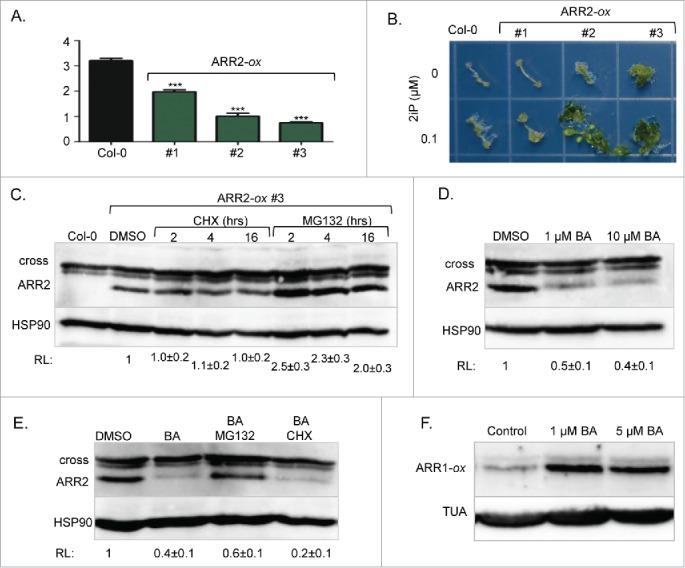Figure 1.

Stability control of ARR2. (A) Effect of ARR2 overexpression (ARR2-ox) on the root length. Seeds were sown and grown on vertically positioned plates with half-strength Murashige and Skoog growth (MS/2) media. After seven days of growth, seedlings were photographed and root length was measured using ImageJ. Data are presented and mean ± SD (n≥12 ). ***, p<0.001 (B) Shoot induction assay. Plants grown on MS/2 media for 7 d under dark conditions were exposed to light for 4 d to strengthen etiolated hypocotyls. Hypocotyls were then excised and placed on MS/2 media containing 1 µM NAA with or without 0.1 µM 2iP. Explants incubated on shoot induction media for 40 d were transferred to a new plate for photography. 2iP, N6-(2-isopentenyl)adenine. (C) Seven-day-old ARR2-ox #3 seedlings were treated for 2, 4 or 16 hours with 200 µM of the protein synthesis inhibitor cycloheximide (CHX) or 100 µM of the proteasome inhibitor MG132 as described.3 Immunoblotting analyses were done as described.3 Proteins were resolved on a 6% acrylamide SDS/PAGE gel. After probing with anti-ARR2 antibodies, membranes were re-probed with anti-HSP90 sera to demonstrate equal loading. Mean ± SD (n≥3 ) of the relative signal intensity (RL) is shown below the blot. (D) Seven-day-old ARR2-ox #3 seedlings were treated for 4 hours with 1 µM or 10 µM of the cytokinin BA. Immunoblotting was done as described in C. (E) Seven-day-old ARR2-ox #3 seedlings were treated for 4 hours with 1 µM of BA in the absence or presence of 100 µM MG132 or 200 µM CHX. (F) Seven-day-old transgenic plants overexpressing ARR1 (ARR1-ox) were treated for 4 hours with 1 µM or 5 µM BA. Proteins were resolved on 7.5% acrylamide SDS/PAGE gels. After probing with anti-ARR1 antibodies, membranes were re-probed with anti-α tubulin (TUA) antibodies.
